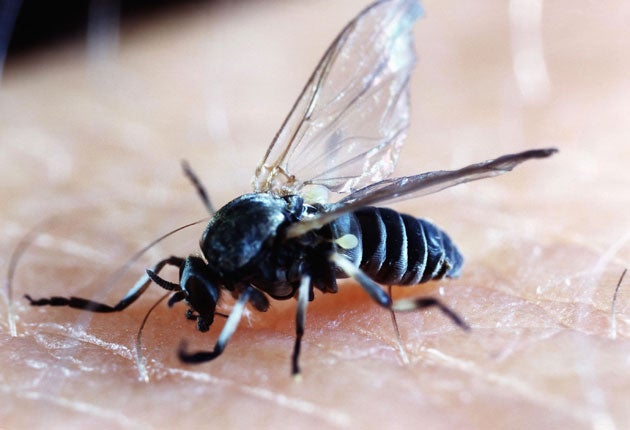Revealed: The rural flies with a taste for city flesh

They are small, winged, and have a thirst for human blood. And their scissor-like mandibles are sharp enough to deliver a painful bite.
Blackflies are being blamed for an upsurge in the number of people experiencing severe reactions after being bitten by insects. In some cases, victims have suffered grotesquely swollen limbs, requiring hospital treatment with intravenous antibiotics.
The encroachment of blackflies from the countryside, where they breed in fast-flowing streams, into more heavily populated urban areas is thought to be one factor behind the increase.
The flying insects are larger than midges measuring 3mm to 7mm long. But their key characteristic is their mouth parts, which are perfectly adapted to hook on to and slice into their human hosts.
Anecdotal reports suggest an increase in the number of victims with infected insect bites serious enough to require hospital treatment. The 23-year-old singer Mollie King from pop group The Saturdays was forced to abandon a concert earlier in the summer after being bitten by an insect. The golfer Ian Poulter also pulled out of the French Open after a bite on his shin became infected. Guests at the Royal garden parties at Buckingham Palace have also been bitten, according to reports.
Stuart Hine, an entomologist at the Natural History Museum, said: "Blackflies are quite pernicious. Their mouth parts are scissor-like and they lacerate the skin and then suck the blood. They inject an anaesthetic so after the initial bite you can't feel it. When you scratch it and germs get in, then you can get a serious infection.
"Mosquitoes are the biggest biter but there does seem to have been an increase in blackflies in towns and cities in recent years. My theory is the growth of water features in gardens and parks is behind the rise. I have been sent blackfly larvae from all sorts of places including high-tech business parks which have water flowing over granite slabs."
He added: "Individual responses to insect bites vary – some people have an extreme reaction – but most people would get a nasty swelling from a blackfly bite. Since 2006 we have seen an increase in reports of people in urban areas being bitten by blackflies."
The insects are a major nuisance in North America as they are a scourge to livestock, and many states operate control programmes based on spraying pesticides. In Africa, the insect plays a key role in the transmission of the parasite that causes river blindness.
In Britain, a species of blackfly called the Blandford Fly, found around the River Stour near Blandford Forum in Dorset, caused an epidemic of serious bites in the early 1970s. During one six-month period in the spring of 1972, an estimated 600 people visited their doctors in Blandford to be treated for insect bites. In the 1980s the problem was controlled by spraying a biological insectide into weed beds.
The UK Health Protection Agency said it did not collect data on insect bites because they do not transmit disease in this country. However, GPs in some areas have reported increases. Hameed Khan, a senior partner at Loughton Health Centre, Essex, close to Epping Forest, said there had been more patients with severe bites this year.
"The reaction to the bite seems more pronounced. Perhaps it is because older people have lower immunity and a greater tendency to develop cellulitis [an infection of the tissue under the skin]," he said.
Donna Laws-Chapman, practice manager of the Timber Hill Health Centre in Norwich, said: "We have been inundated with patients suffering from insect bites. A lot were infected."
Christian Broughton: 'My leg was so swollen I was sent straight to hospital'
It could have been a black fly. Or a spider – that was the most popular guess among the doctors I grilled. The truth is that I'll never know what it was that bit me on the leg a fortnight ago. But what I have learnt is that not all insect bites can be taken care of with a quick dab of Anthisan or a couple of Piriton.
Unless an allergic reaction is involved, conventional wisdom would tell you that insect bites don't require hospitalisation. So when my calf and thigh tightened up the morning after I'd played cricket, I found myself questioning my fitness levels. By lunchtime, my leg was so swollen, an occupational health nurse feared I had deep-vein thrombosis and sent me to an accident and emergency ward.
I was limping heavily and my leg was getting bigger by the hour. At the hospital I discovered a tiny pin-prick on my calf, and was told: whatever had bitten me "had put something pretty mucky back in". The result was a bacterial infection. I should go home, take antibiotics and come back if it got worse.
The next day when I returned to A&E my leg was too big to pull up my trousers. The tablets weren't working, the infection was "nasty". I would have to stay in for 24 hours for drip-feed antibiotics. There was a concern that it could develop into blood poisoning, or that the infection would spread.
A night on the ward and a week of tablets was enough to bring my leg back to normal, almost as quickly as the problem had surfaced. But the experience was something of an education. Asking around, the anecdotal evidence stacked up – I realise now that I do know people who have spent a night in hospital due to similar infections caused by bites from "harmless" critters, with no allergies or exotic venoms to blame.
Christian Broughton is Sports Editor of 'The Independent'
Join our commenting forum
Join thought-provoking conversations, follow other Independent readers and see their replies
Comments